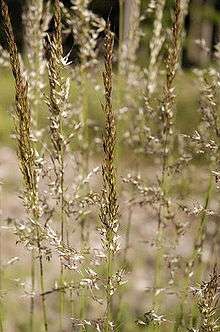Calamagrostis arundinacea
| Calamagrostis arundinacea | |
|---|---|
 | |
| Scientific classification | |
| Kingdom: | Plantae |
| (unranked): | Angiosperms |
| (unranked): | Monocots |
| (unranked): | Commelinids |
| Order: | Poales |
| Family: | Poaceae |
| Genus: | Calamagrostis |
| Species: | C. arundinacea |
| Binomial name | |
| Calamagrostis arundinacea (L.) Roth | |
Calamagrostis arundinacea is a species of bunch grass in the Poaceae family, native to Eurasia, China and India.[1]
Description
The species is perennial and tufted with short rhizomes and erect culms that are 60–150 centimetres (24–59 in) long. Each leaf has a truncate ligule which is 2–4 millimetres (0.08–0.16 in) long, and obtuse. The leaf-blades are 8–50 mm (0.3–2.0 in) by 1.8–10 mm (0.07–0.39 in), hairless and have both a scabrous surface and an attenuate apex. The panicle has a scaberulous peduncle and is lanceolate, open, continuous, and is 8–18 cm (3.1–7.1 in) long by 1–4 cm (0.4–1.6 in) wide. Flowers have a pair of lodicules and stigmas, and three anthers which are 2.4–2.7 mm (0.09–0.11 in) long. The fruit is a caryopsis with an additional pericarp.[1]
References
- 1 2 W.D. Clayton; M. Vorontsova; K.T. Harman; H. Williamson. "Calamagrostis arundinacea". Royal Botanic Gardens. Kew: The Board of Trustees. Retrieved March 31, 2013.